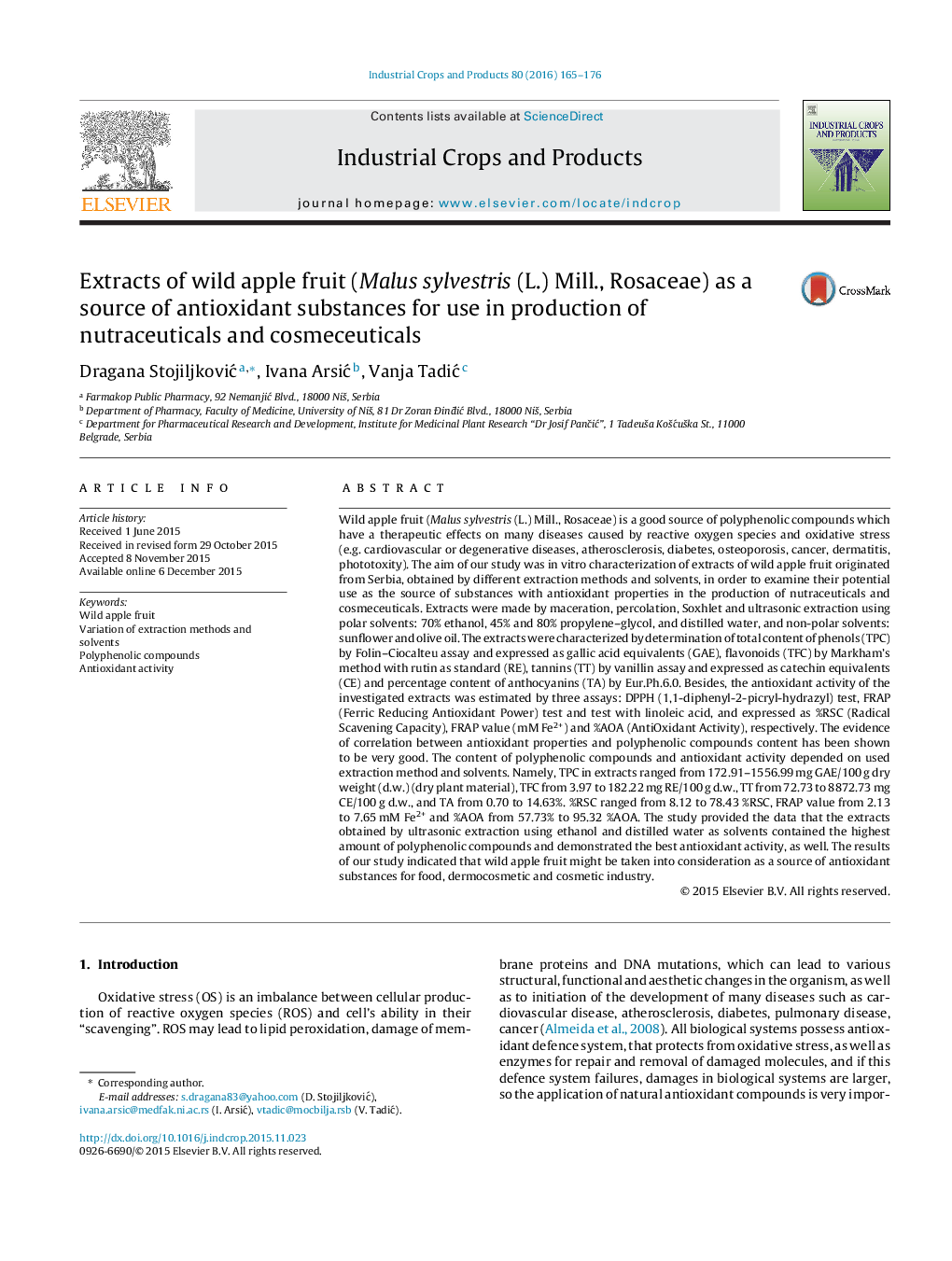| کد مقاله | کد نشریه | سال انتشار | مقاله انگلیسی | نسخه تمام متن |
|---|---|---|---|---|
| 4512585 | 1624830 | 2016 | 12 صفحه PDF | دانلود رایگان |

• Selection of a suitable extraction method and solvent.
• In vitro investigation of the polyphenolic content and antioxidant activity.
• Correlation between content of polyphenolic compounds and antioxidant activity.
• Potential usage of wild apple as feedstock materials in food and cosmetic industry.
• Specific geographic origin of the plant influencing its chemical composition.
Wild apple fruit (Malus sylvestris (L.) Mill., Rosaceae) is a good source of polyphenolic compounds which have a therapeutic effects on many diseases caused by reactive oxygen species and oxidative stress (e.g. cardiovascular or degenerative diseases, atherosclerosis, diabetes, osteoporosis, cancer, dermatitis, phototoxity). The aim of our study was in vitro characterization of extracts of wild apple fruit originated from Serbia, obtained by different extraction methods and solvents, in order to examine their potential use as the source of substances with antioxidant properties in the production of nutraceuticals and cosmeceuticals. Extracts were made by maceration, percolation, Soxhlet and ultrasonic extraction using polar solvents: 70% ethanol, 45% and 80% propylene–glycol, and distilled water, and non-polar solvents: sunflower and olive oil. The extracts were characterized by determination of total content of phenols (TPC) by Folin–Ciocalteu assay and expressed as gallic acid equivalents (GAE), flavonoids (TFC) by Markham's method with rutin as standard (RE), tannins (TT) by vanillin assay and expressed as catechin equivalents (CE) and percentage content of anthocyanins (TA) by Eur.Ph.6.0. Besides, the antioxidant activity of the investigated extracts was estimated by three assays: DPPH (1,1-diphenyl-2-picryl-hydrazyl) test, FRAP (Ferric Reducing Antioxidant Power) test and test with linoleic acid, and expressed as %RSC (Radical Scavening Capacity), FRAP value (mM Fe2+) and %AOA (AntiOxidant Activity), respectively. The evidence of correlation between antioxidant properties and polyphenolic compounds content has been shown to be very good. The content of polyphenolic compounds and antioxidant activity depended on used extraction method and solvents. Namely, TPC in extracts ranged from 172.91–1556.99 mg GAE/100 g dry weight (d.w.) (dry plant material), TFC from 3.97 to 182.22 mg RE/100 g d.w., TT from 72.73 to 8872.73 mg CE/100 g d.w., and TA from 0.70 to 14.63%. %RSC ranged from 8.12 to 78.43 %RSC, FRAP value from 2.13 to 7.65 mM Fe2+ and %AOA from 57.73% to 95.32 %AOA. The study provided the data that the extracts obtained by ultrasonic extraction using ethanol and distilled water as solvents contained the highest amount of polyphenolic compounds and demonstrated the best antioxidant activity, as well. The results of our study indicated that wild apple fruit might be taken into consideration as a source of antioxidant substances for food, dermocosmetic and cosmetic industry.
Journal: Industrial Crops and Products - Volume 80, February 2016, Pages 165–176